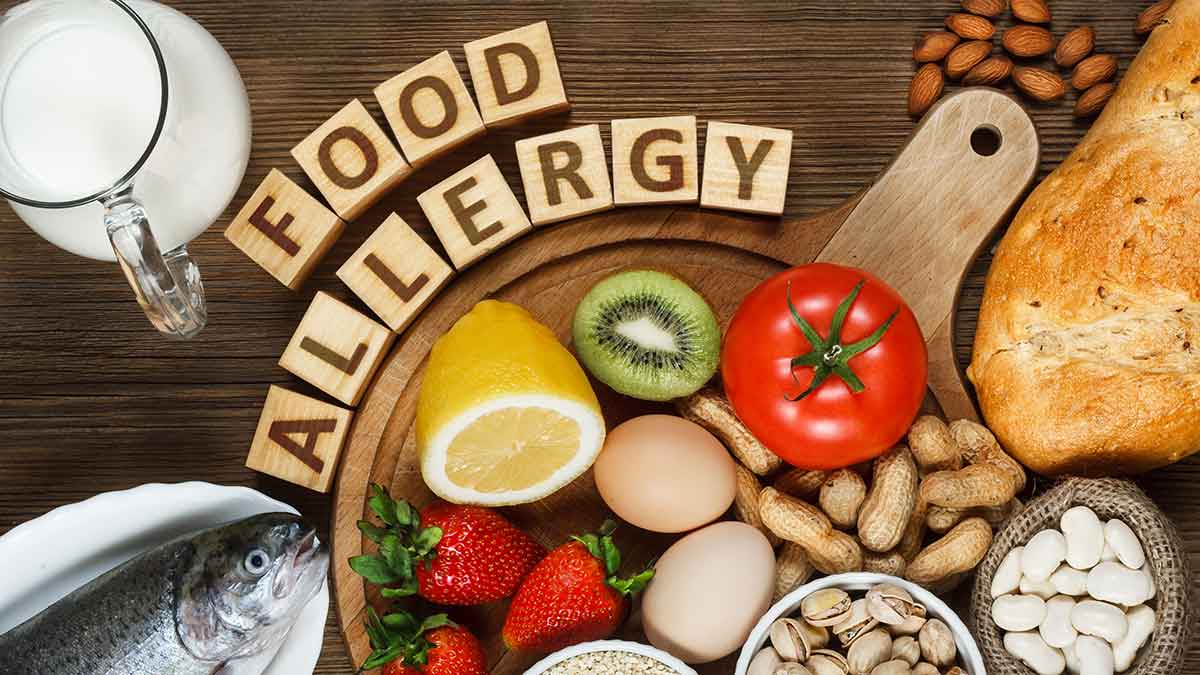Well-being
JHAH Well-being: Food allergies and child care

Global July 04, 2023
As many as one out of 12 children are estimated to have food allergies globally.
Food allergies have become increasingly prevalent among children, creating significant challenges for parents and health care professionals. Pediatric food allergies occur when a child’s immune system negatively reacts to certain foods, triggering various symptoms.
Food allergies can develop at any age, but are more common in children. It is estimated that 5% to 8% of children worldwide have a food allergy.
Understanding food allergies
Food allergies occur when the immune system mistakenly identifies certain proteins in food as harmful and causes an allergic reaction. The most common food allergens in children include milk, eggs, peanuts, tree nuts, soy, wheat, fish, and shellfish.
Allergic reactions can range from mild symptoms like hives and itching to severe reactions such as anaphylaxis, which can be life-threatening.
Causes of food allergies
The exact cause of pediatric food allergies are not fully understood; however, several factors have been identified as potential contributors. One significant factor is the child’s genetic predisposition. If one or both parents have allergies, the child is more likely to develop them.
Signs and symptoms: Detecting food allergies in children
Detecting food allergies in children can be challenging as symptoms can vary widely and may be mistaken for other conditions. Parents and health care providers must be vigilant and observant of any unusual reactions after eating certain foods.

Types and levels of allergies
Pediatric food allergies can manifest in various ways, with symptoms ranging from mild to severe. Allergic reactions can be classified into four levels:
- Mild reactions: May include hives, itching, or mild abdominal discomfort. These symptoms typically resolve quickly with minimal intervention such as using antihistamines.
- Moderate reactions: Can include more pronounced symptoms such as gastrointestinal distress, breathing difficulties, or generalized hives. Medical intervention, such as epinephrine, may be necessary to manage these reactions.
- Severe reactions: Known as anaphylaxis, these reactions are potentially life-threatening and require immediate emergency medical attention. Symptoms may include difficulty breathing, a drop in blood pressure, swelling of the throat, and loss of consciousness.
- Delayed: Some food allergies can manifest with delayed reactions, making diagnosis challenging. Symptoms may appear hours or even days after consuming the allergen, making it difficult to pinpoint the cause.
Safeguarding children with food allergies
Once a child has been diagnosed with a food allergy, it is essential to safeguard his or her health and well-being. Here are some strategies that can help:
- Education and Awareness: Parents, caregivers, and teachers should be educated about food allergies, including recognizing symptoms, avoiding allergens, and appropriately responding to allergic reactions.
- Allergen Avoidance: Avoiding allergenic food is the most effective way to prevent an allergic reaction. Parents should carefully read food labels and be aware of hidden allergens in processed foods.
- Emergency Action Plan: Parents should work with their child’s health care provider to develop an emergency action plan.
It is often difficult to recognize that a child is suffering from an allergy; however, if you suspect that your child may have an allergy, discuss it with his or her JHAH pediatrician who may refer you to a JHAH pediatric allergy specialist, and if necessary, to a JHAH nutrition specialist.
Here are some allergen-friendly recipes

Allergen-Friendly Chocolate Chip Cookies
If you have children with dairy, egg, nut, wheat or soy allergies, this recipe for allergen-friendly chocolate chip cookies is perfect for you! These delicious cookies are free from all major allergens, so your little ones can enjoy a tasty treat without worries.
Ingredients
- 2 1/2 cups gluten-free flour
- 1 teaspoon baking soda
- 1/2 teaspoon salt
- 1/2 cup coconut oil, melted
- 1 cup packed brown sugar
- 1/4 cup unsweetened applesauce
- 1/4 cup dairy-free, soy-free milk (such as almond or oat milk)
- 2 teaspoons vanilla extract
- 1 cup dairy-free chocolate chips
Instructions
- Preheat oven to 350°F (175°C) and line baking sheet with parchment paper.
- Whisk gluten-free flour, baking soda and salt in a medium bowl. Set aside.
- Mix melted coconut oil and brown sugar in a large mixing bowl until well combined. Add unsweetened applesauce, dairy-free milk and vanilla extract. Mix until smooth and creamy.
- Gradually add dry ingredients to wet ingredients, mixing well after each addition. The dough should be thick and slightly sticky.
- Fold in dairy-free chocolate chips until evenly distributed in the dough.
- Using a tablespoon or a cookie scoop, drop rounded portions of dough onto the prepared baking sheet, spacing them about 2 inches apart.
- Bake for 10-12 minutes or until edges are golden brown. The centers may still appear slightly soft but will firm up as cookies cool.
- Allow cookies to cool on the baking sheet for 5 minutes, then transfer them to a wire rack to cool completely.
These allergen-friendly chocolate chip cookies are sure to be a hit with children and adults alike. Enjoy them as a snack or dessert, and feel confident knowing they are safe for everyone to enjoy. Happy baking!
Allergy-Friendly Veggie Pizza Recipe
This allergy-friendly veggie pizza recipe is perfect for children with dairy, egg, nut, wheat or soy allergies. It is delicious, easy to make and packed with healthy ingredients. Let's get started!
Ingredients
Crust
- 2 cups gluten-free flour
- 1 teaspoon baking powder
- 1/2 teaspoon salt
- 1/4 cup olive oil
- 1/2 cup warm water
Sauce
- 1 cup tomato sauce (check for allergens)
- 1 teaspoon dried oregano
- 1/2 teaspoon garlic powder
- Salt and pepper to taste
Toppings
- 1 cup dairy-free cheese (e.g., vegan mozzarella or cheddar)
- 1 cup sliced vegetables (e.g., bell peppers, mushrooms, onions, tomatoes)
- Fresh basil leaves (optional)
Instructions
- Preheat oven to 425°F (220°C) and line a baking sheet with parchment paper.
- Whisk gluten-free flour, baking powder and salt in a large bowl. Add olive oil and warm water then stir until a soft dough forms. If dough seems too dry, add additional warm water one tablespoon at a time.
- Transfer dough onto the prepared baking sheet and use hands to press it into a thin, even crust. You can also use a rolling pin.
- Bake crust in the oven for 10-12 minutes or until lightly golden.
- While crust is baking, prepare sauce by combining tomato sauce, dried oregano, garlic powder, salt and pepper in a small bowl.
- Remove crust from the oven and spread sauce evenly over the top.
- Sprinkle dairy-free cheese over the sauce followed by sliced vegetables.
- Return pizza to the oven and bake for an additional 10-12 minutes or until the cheese has melted and the vegetables are tender.
- Remove from oven and let pizza cool for a few minutes before slicing. Garnish with fresh basil leaves if desired.
Enjoy your allergy-friendly veggie pizza! Remember, you can customize toppings to suit your child's preferences.
Egg-Free and Dairy-Free Chocolate Cake Recipe
This delicious chocolate cake recipe is perfect for children with milk, egg and soy allergies. It uses alternative ingredients to create a moist and flavorful cake for everyone. The recipe is simple and easy to follow, so let's get started!
Ingredients
Cake
- 2 1/2 cups all-purpose flour
- 2 cups granulated sugar
- 3/4 cup unsweetened cocoa powder
- 2 teaspoons baking soda
- 1/2 teaspoon salt
- 2/3 cup vegetable oil
- 2 cups almond milk (or any other nondairy, nonsoy milk)
- 2 teaspoons vanilla extract
- 2 tablespoons apple cider vinegar
Frosting
- 1 cup dairy-free margarine
- 3 1/2 cups powdered sugar
- 1/2 cup unsweetened cocoa powder
- 1/4 cup almond milk (or any other non-dairy, non-soy milk)
- 1 teaspoon vanilla extract
Instructions
Cake
- Preheat oven to 350°F (175°C) and grease a 9x13-inch baking pan with dairy-free margarine or cooking spray.
- Whisk the flour, sugar, cocoa powder, baking soda and salt in a large mixing bowl until well combined.
- Add the vegetable oil, alternative milk and vanilla extract to the dry ingredients. Mix until batter is smooth and no lumps remain.
- Stir in apple cider vinegar for an additional minute. The vinegar will react with the baking soda, creating a light, fluffy texture.
- Pour batter into the prepared baking pan and spread evenly with a spatula.
- Bake in pre-heated oven for 30-35 minutes or until a toothpick inserted into the center comes out clean.
- Remove cake from the oven and let cool completely in the pan before frosting.
Frosting
- In a medium mixing bowl, beat dairy-free margarine until smooth and creamy.
- Gradually add powdered sugar and cocoa powder, alternating with the milk. Beat well after each addition until the frosting is light and fluffy.
- Stir in vanilla extract and mix until combined.
Assembling Cake
- Once the cake has cooled, carefully remove it from baking pan and place on a serving plate or cake stand.
- Spread a generous amount of frosting over the cake using a spatula or butter knife. The slides can be frosted as well if you prefer.
- Decorate cake with sprinkles, chocolate shavings or other toppings.
- Allow frosting to set for at least 30 minutes before serving.
Enjoy!



